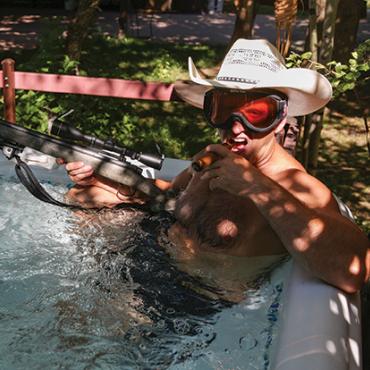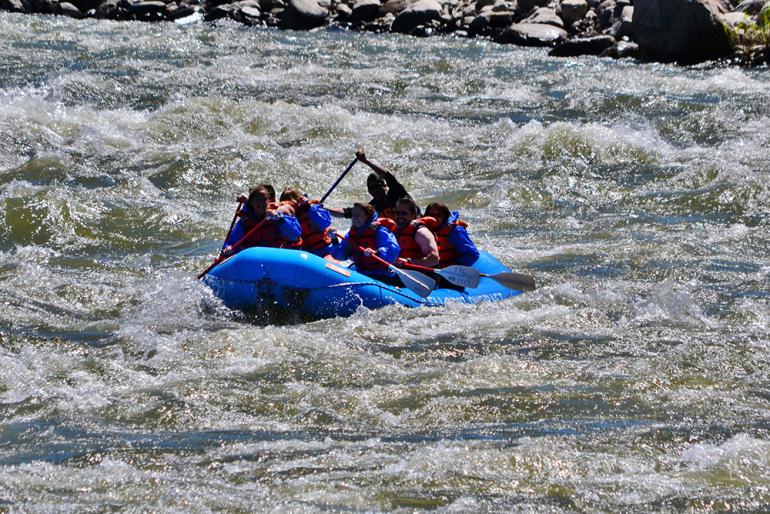Three Days, Three Rivers
Exuberance meets caution in the roiling snowmelt of southwest Montana.
The river was huge. Swollen and discolored from the previous night's rainfall, it looked like a swirling sea of chocolate milk. As I stepped into the water and felt the current against my legs, the first of what would be several visitations from the dreaded anxiety demons sent a violent shudder through my body.
"Cold?" my friend Shawn asked from inside the raft, where he was tying down the last of our gear.
"Yeah, a little," I lied. At 7:00 a.m. the water was actually a bit warmer than the brisk morning air. But Shawn and I had never been whitewater rafting together, and damned if I was going to admit to fear this early in the trip. In a burst of ego-driven intensity I choked down the demon. "Let's go!" I yelled, and with a deep breath pushed us into the tumultuous water of the Yellowstone River.
It was the beginning of a three-day, three-river rafting weekend, and though we didn't yet know it, we were in over our heads.
The "Big Three" of Bozeman-area whitewater consists of the Yellowstone, Gallatin, and Madison rivers. They're all similar in that most of each river is relatively serene class I and II water, except for one particular stretch that, during spring runoff, can launch the river's status to a forbidding class IV – even class V during big snow years. This makes for some incredible whitewater action—just the kind we were looking for this weekend. Shawn, his brother Chad, their friend Steve, and I were determined to tackle every major rapid on all three rivers in one long weekend. This meant a run through Yankee Jim Canyon, on the Yellowstone; a trip through Gallatin Canyon, past the fabled House Rock; and a day in the Madison's treacherous Beartrap Canyon, home of that notorious and morale-shattering rapid known as the Kitchen Sink.
We'd just maneuvered the raft into position when the first rapid hit. The bow shot up, then back down, raising the stern high into the air. Everyone whooped in unison as we entered the roiling mass of water. A sudden jerk forward, and then the boat leveled out as we punched through. Water sprayed up and over the entire boat.
Soaked and smiling, we pressed on, taking seven or eight more decent rapids before the river flattened out. We donned our Liz Taylor shades —$5 disposables we'd picked up at the gas station in Gardiner—and relaxed for the long, calm float to Yankee Jim.
After a couple of hours, the rock walls of the canyon loomed ahead. Without a word, we quaffed our beers and sat up, ready for action. For me, that's one of the greatest offerings of river rafting: commingling the human need for tranquillity and the human lust for excitement. Learning to balance these competing proclivities is usually a lifelong goal, and smoothing out the transitions between them the task of philosophers, priests, and psychiatrists. Today, the river was doing all the work for us, and for free.
As we entered the canyon, the sun disappeared behind a cliff, casting a dark shadow across the river. We worked through a series of individual rapids and a long stretch of rough water. Then it came into view: that tremendous, nameless wall of water that commands both dread and reverence from rafters throughout the state. It was "the Rapid": Yankee Jim's immense self-regenerating wave, a mass of swirling water curled high as if ready to crash down at any moment—but never quite making it, rolling on and on into infinity. "That wave must be really frustrated," Chad mused as we approached it. "I'll bet it would like nothing more than to crush us like peanuts."
We hit the pissed-off wall of water head-on. Before we knew what was happening, the wave's trough completely engulfed the bow, pitching the back end up and over. We went flying in five different directions. In mid-air I noticed a tourist standing on the road, staring at us, mouth agape. Then, with a splash, I entered the frigid water of the Yellowstone River.
Surfacing, I looked around to see the boat upside-down and my three companions swimming toward it. My left sandal had come off and was rapidly drifting away from me. I heard Shawn yelling at Chad and Steve to get on one side of the raft, help him flip it over, and to jump back in before the next set of rapids. I went for my shoe, grabbed it, and swam back to the raft just in time.
I joined the others on the upstream side of the raft, and together we reached up, grabbed a good hold, and heaved the boat over. One by one we clambered in. Shawn was last, and just as we hauled him in we hit the first rapid. The jolt sent everyone sprawling—but we were up instantly, paddles in hand, and with a few hard strokes we straightened out the boat and took the last few rapids easily.
With Yankee Jim under our belts, we retrieved the drop-off vehicle and made for the Gallatin. It took about two hours, and by the time we arrived at our campsite, the collective giddiness from the day's excitement had worn off. We spread our bags around the fire and fell into a deep and tranquil sleep.
The Gallatin is a comely river if ever there was one, and part of its beauty lies in its diversity: shifting from a slow and sinuous stream south of Big Sky, the river lowers its head and charges through the mountains with a raw, gut-wrenching power. We chose its most potent precinct: the Mad Mile, a long, turbulent stretch of water that throws your boat around like a bumper car.
We shot through the Mad Mile's upper rapids—Showstopper, Old Bridge, Snaggletooth—without a hitch, whooping and hollering the whole way. Then we broke into an expanse of mild water. Thick pines bordered the river, and we watched as a lone moose ambled down to the edge and dipped his snout in for a drink.
One can't spend much time on the Gallatin and not make certain observations. The lush fields of grass; the steep, forested slopes; the majestic peaks looming in the distance: all these are individual panes to a larger prism, through which we can glimpse the collective beauty of the natural world.
Rivers are worlds in themselves, though, and they operate according to their own rules. An environment in constant motion: ever-changing, swift, seemingly chaotic—yet somehow peaceful, harmonious. The river is a world of unknowns, and only with firsthand experience, through an intimate, direct relationship with the river, can you learn its mysteries. I guess that's why I like to snorkel the Gallatin sometimes: to get down beneath the surface, to get into the water rather than above it, and see how it operates.
Right then, the Gallatin was operating like a Baja racer on coke. A look downstream revealed a minefield of detonating whitecaps. We straightened the boat, braced ourselves, and bounced through them with boyish glee. Then around a bend, and there it was: House Rock, the enormous and legendary monolith of the Gallatin River. It looked like the Cracken rising out of the Aegean Sea, cold and menacing. The demons came again. You're going to hit the rock, they hissed, and crack open your skull like an eggshell.
"Go left!" Shawn yelled over the roar of the water. "It's narrower, but I think we'll be able to hit it straight. Just don’t get sucked into the rock!"
We steered the raft over, and everyone took a deep breath as the river grabbed us and shot us through the narrow passage. Water sprayed everywhere as we bounced up and down over the broiling waves. As we fought to keep the boat straight, House Rock whizzed by only inches away.
Then we were past. We whooped our victory, bounced through the remainder of the Mad Mile, and made for the take-out. Day two was over and night was coming on. We were alive, uninjured... and ready to make camp, rack out, and dream of the mighty Beartrap.
Day three: the Madison was as unfriendly as the others—on the first rapid, Steve and I went flying. I popped up, saw huge rocks just ahead, and somehow defied gravity as I shot out of the water and into the boat like a flying fish. We hauled Steve in and prepared to maneuver through the next rapid sequence. I wedged my foot tight under the thwart, and held my oar in a death-grip.
It was noon in Beartrap Canyon. We'd slept in, exhausted from our previous two days of paddling. And we needed our rest: the Beartrap didn't have the huge walls of water like the Yellowstone, or the long, rushing chutes of the Gallatin, but it had rocks—big rocks, and lots of them. It was basically a peril-laden boulder-field that demanded strength, attention, quick judgment... and lots of luck.
The next few rapids were fun and easy: big bounces and lots of splashing water—but no inadvertent ejections. We had a feel for the raft by now, what it could do and what it couldn't, and so maneuvering it around rocks was fairly easy. Between the stretches of rough water, we gazed around and marveled at Beartrap Canyon. The verdant banks were thick with blooming cottonwoods; grassy slopes, speckled with pine, rose to each side; deer grazed lazily in shaded draws; and hawks rode thermals high overhead. Most striking, though, was the overwhelming sense of remoteness, of wildness. Unlike the Gallatin and the Yellowstone, there's no highway paralleling the canyon stretch of the Madison, no sign of human presence anywhere. When you hit the Beartrap, you're in the woods, baby, and there's no way out but downstream.
We cruised along, lost in our individual thoughts. And then it was there: the Kitchen Sink. We'd never been down this river, we had no map, but we knew it was the Kitchen Sink by the sheer impossibility of it. We rowed ashore to take a closer look. Huge rocks at the front of the rapid funneled into a narrow drop-off. Refrigerator-sized stones barricaded the sides, and submerged boulders between them created a flat pool that spilled off into another rock field. The only way out without flipping the raft and sending us all bouncing off the rocks like human pinballs was a narrow chute on the far left side of the pool. To make it we'd have to stick the drop-off, turn on a dime, and paddle like mad to the chute on the other side of the pool—all without getting sucked off the end and into the rocks.
So there we were, four guys in a rented rubber boat, looking at this behemoth of a rapid, this single fragment of nature that held the power to destroy us—and quickly, easily, indifferently. No one said a word. After a few minutes Shawn looked over at me.
Now, Shawn and I have innumerable life-threatening activities to our credit: pointing our skis and launching off enormous cornices, cliff-jumping 80 feet into water of uncertain depth, scaling sheer rock faces without ropes, provoking rattlesnakes, driving through Los Angeles's ghettos at night, drinking ourselves to oblivion and passing out in fraternity houses—and never once have I seen his face assume this particular expression. It was fear: cold, unbridled fear.
And God bless him, because I was scared to death too—the demons were inside my head again, screaming this time—and if he hadn't divulged his own misgivings, I'd have felt pretty damn old.
I nodded imperceptibly, and our shared fear, our shame at being afraid, our inexplicable emotional intensity at that moment—all this passed between us without a word. Chad and Steve watched the river with wide eyes. "Well, what do you think?" asked Chad, his voice aquiver.
And suddenly the world seemed small, very small. I could feel the tingling of infinite pinpricks as the universe shrunk to fit inside my body. Everything was reduced to that moment: all our excitement from the past three days, our anticipation and giddiness, our unremitting desire for still more exhilaration and glee. All our apprehension and fear, all our human wants and needs, all the puzzling human propensities that make us want to sit in a rubber raft and be thrown headlong over bone-crushing rapids. And then an understanding, a moment of clarity: when it comes right down to it, the reason we do this is not to tempt death. No, not death. It's to engage life, to enhance life by entertaining the possibility of death—and to survive the engagement with all our limbs and facial features intact.
We all looked at Shawn.
"Let's portage," he said, and without a word we hopped out of the raft and waded past the Kitchen Sink.













